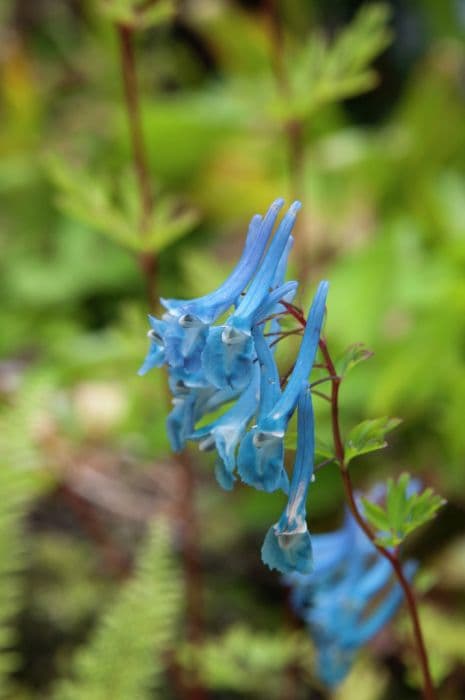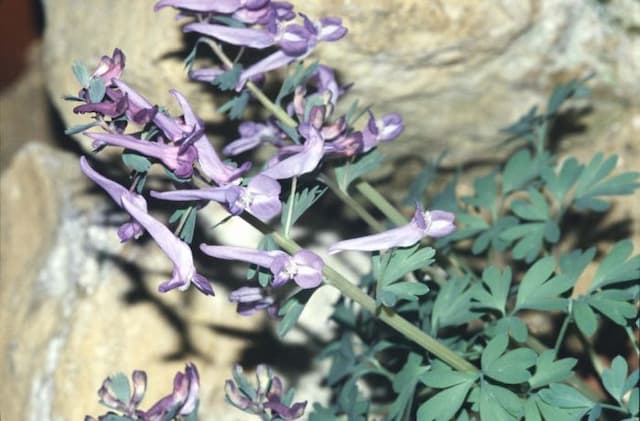Oriental Poppy Papaver (Oriental Group) 'Aglaja'

ABOUT
Oriental poppy 'Aglaja' is a striking and dramatic plant known for its brilliant display of flowers. It produces large, bowl-shaped blooms that can catch anyone's eye with their bright, satiny petals. The flowers are typically a deep pink to magenta in color, with a unique black blotch at the base, giving them a distinct and eye-catching appearance. Deeply cut, feathery foliage of a rich green color provides an attractive backdrop to these showstopping flowers. The leaves are hairy and somewhat bristly to the touch. After blooming, the plant leaves behind an interesting seed pod, which starts off being a green, swelling into a capsule-shape as it matures, and then drying to a papery brown texture that can add interest even after the plant has finished flowering. Oriental poppy 'Aglaja' brings a sense of traditional cottage garden style to any garden, with its old-world charm and magnificent blooms that are a favorite among gardeners and pollinators alike.
About this plant
 Names
NamesFamily
Papaveraceae
Synonyms
Oriental Poppy, Aglaja Poppy
Common names
Papaver orientale 'Aglaja'
 Toxicity
ToxicityTo humans
Oriental poppy, which is a member of the genus Papaver, can be toxic to humans if parts of the plant are ingested. Although Oriental poppies are not the most toxic within the Papaver genus, caution should be exercised. All parts of the plant, especially the seeds, contain alkaloids that can be poisonous. Symptoms of poisoning can include nausea, vomiting, dizziness, and sedation. Respiratory depression can occur in more severe cases but is unlikely with accidental ingestion of small quantities. Always seek medical advice if ingestion occurs and symptoms develop.
To pets
Oriental poppy can also have toxic effects on pets if ingested. Similar to the effects on humans, pets that consume any part of the Oriental poppy may experience symptoms such as nausea, vomiting, dizziness, and even sedation. It is important to prevent pets from ingesting this plant and to consult a veterinarian promptly if you suspect your pet has consumed any part of an Oriental poppy.
 Characteristics
CharacteristicsLife cycle
Perennials
Foliage type
Deciduous
Color of leaves
Green
Flower color
Pink
Height
2-3 feet (60-90 cm)
Spread
1-2 feet (30-60 cm)
Plant type
Herb
Hardiness zones
3-7
Native area
Asia
Benefits
 General Benefits
General Benefits- Attracts Pollinators: The Papaver 'Aglaja', commonly known as the Oriental Poppy, has vivid, colorful blooms that attract bees, butterflies, and other beneficial pollinators to the garden.
- Drought Tolerance: Once established, Oriental Poppies are drought-resistant, making them suitable for waterwise gardens and regions with low rainfall.
- Low Maintenance: These perennials require minimal care once they are established. They do not need regular watering or fertilizing, which makes them ideal for gardeners looking for low-maintenance plants.
- High Impact Visual Appeal: With their striking colors and large, papery flowers, Oriental Poppies add dramatic flair to any garden setting, serving as an excellent focal point.
- Herbaceous Perennial: As a perennial, Oriental Poppies return year after year, offering long-term value and reducing the need to replant annually.
- Deer and Rabbit Resistant: These plants are generally resistant to browsing by deer and rabbits, making them suitable for gardens plagued by these animals.
- Diverse Landscaping Uses: Oriental Poppies can be used in a variety of garden settings, including borders, rock gardens, and mixed perennial beds.
- Ease of Propagation: They can be easily propagated by dividing the roots, allowing gardeners to create more plants for other areas of the garden or to share with friends.
- Seasonal Interest: Oriental Poppies provide a burst of color in late spring to early summer, filling the gap between the spring bulbs and the summer perennials.
- Improves Garden Dynamics: The presence of Oriental Poppies can support an ecosystem that is inviting to various insects, contributing to the overall health and biodiversity of the garden.
 Medical Properties
Medical PropertiesThis plant is not used for medical purposes.
 Air-purifying Qualities
Air-purifying QualitiesThis plant is not specifically known for air purifying qualities.
 Other Uses
Other Uses- Photography Prop: Due to the vibrant color and bold appearance, Oriental Poppies like 'Aglaja' are often used by photographers to create visually striking images in nature photography.
- Garden Design: Oriental Poppies can be used to create a focal point in garden designs, particularly in cottage and meadow-style gardens, because of their striking flowers.
- Drying for Crafts: The seed pods of Oriental Poppies are sometimes dried and used in floral arrangements or for crafting wreaths and other decorations.
- Educational Tool: Educators might use Oriental Poppies to demonstrate to students how perennial plants emerge and bloom each year and how they go dormant after flowering.
- Ink Production: Historically, poppy petals have been used to produce natural red dyes, which can be used in ink-making for art or calligraphy.
- Culinary Garnish: Although not commonly consumed, the petals of Oriental Poppies can occasionally be used as a colorful, albeit short-lived, garnish for high-end culinary dishes.
- Fabric Pattern Inspiration: The distinctive look of Oriental Poppies can inspire artists and designers in creating pattern designs for fabrics and wallpapers.
- Land Art: The bright, ephemeral flowers can be used by land artists to create outdoor installations and natural art pieces that emphasize impermanence and seasonal change.
- Botanical Studies: 'Aglaja' can be included in botanical studies and plant collections in order to help understand the diversity within the genus Papaver.
- Pollinator Attraction: Oriental Poppies are attractive to bees and other pollinators, making them ideal for planting in gardens aimed at supporting local ecosystems.
Interesting Facts
 Feng Shui
Feng ShuiThe Oriental poppy is not used in Feng Shui practice.
 Zodiac Sign Compitability
Zodiac Sign CompitabilityThe Oriental poppy is not used in astrology practice.
 Plant Symbolism
Plant Symbolism- Rest: Poppies are often associated with restful sleep and recovery, drawing connections to the opium derived from some varieties and its sedative effects.
- Peace: Poppies symbolize peace because they were some of the first flowers to grow on the battlefields of World War I after the fighting ended, representing both a consolation for loss and hope for a peaceful future.
- Remembrance: Poppies are emblematic of remembrance, especially for soldiers who have died during wartime, primarily because of the poem "In Flanders Fields" where the vivid red blooms are described amidst war graves.
- Resilience: The ability of poppies to bloom after disturbance to the soil can represent resilience and the capacity to recover from adversity.
- Beauty and Success: The 'Aglaja' variety, named after one of the Charites (Graces) from Greek mythology, can be interpreted as symbolizing beauty, charm and grace, qualities attributed to these deities, and by extension can suggest success.
 Water
WaterOriental poppies like 'Aglaja' should be watered deeply but infrequently to encourage deep root growth; typically, once a week is sufficient, depending on the weather conditions. During hot and dry periods, they may require more frequent watering. Aim for about one inch of water per week, which translates to about 0.6 gallons for a medium-sized plant. Ensure the soil is well-draining and does not remain waterlogged to prevent root rot. During the winter dormant period, reduce watering significantly to reflect the plant's reduced need for moisture.
 Light
LightOriental poppies such as 'Aglaja' thrive in full sun to light partial shade. They perform best when they receive at least six hours of direct sunlight per day. Plant 'Aglaja' in a spot where it's exposed to the early morning and afternoon sun with some protection during the hottest part of the day, if possible.
 Temperature
TemperatureOriental poppies like 'Aglaja' can tolerate a wide range of temperatures but prefer cooler conditions. They are hardy in temperatures as low as -20 degrees Fahrenheit and can handle up to around 90 degrees Fahrenheit, though they may go dormant in the peak of summer heat. The ideal growing temperatures for 'Aglaja' are between 50 and 75 degrees Fahrenheit, with cooler night temperatures especially beneficial for flowering.
 Pruning
PruningPruning Oriental poppies like 'Aglaja' is primarily for aesthetic reasons and to promote health. Deadhead spent flowers to encourage additional blooming and to prevent the plant from using energy to set seed. Cut back the foliage to ground level after it dies back in the summer to keep the garden tidy. Pruning is typically done after the first flowering in late spring or early summer, and no regular pruning is necessary beyond this.
 Cleaning
CleaningAs needed
 Soil
SoilOriental Poppy 'Aglaja' thrives in well-draining soil with a pH range between 6.5 and 7.5. An optimal soil mix can be made with equal parts of loamy garden soil, compost, and gritty material like sand or perlite to ensure proper drainage.
 Repotting
RepottingOriental Poppy 'Aglaja' seldom needs repotting as it does not appreciate disturbance. It's best to repot only if it's absolutely necessary due to overgrowth, which is typically every few years.
 Humidity & Misting
Humidity & MistingOriental Poppy 'Aglaja' is tolerant of a wide range of humidity levels and does not require any specific humidity conditions. These poppies are quite adaptable to outdoor humidity levels.
 Suitable locations
Suitable locationsIndoor
Provide full sun, well-draining soil, and cooler temperatures.
Outdoor
Plant in full sun, well-drained soil; protect from high winds.
Hardiness zone
3-9 USDA
 Life cycle
Life cycleThe Oriental Poppy 'Aglaja' begins its life cycle when the seeds are sown in the soil, either in the fall or early spring. Germination follows, which typically occurs within two weeks under ideal conditions of warmth and moisture. Once the seedlings emerge and develop true leaves, they enter the vegetative stage, growing foliage and establishing a strong root system. The plant then enters the reproductive stage, producing large, showy flowers usually in late spring or early summer that attract pollinators. After pollination, the flowers fade and seed pods form, eventually drying and releasing seeds for the next generation. Finally, the plant enters dormancy in the late summer, with leaves and stems dying back to the ground until the next growing season.
 Propogation
PropogationPropogation time
Spring
The Oriental Poppy 'Aglaja' is best propagated by seed, and the ideal time to do so is in late summer or early autumn. To propagate by seed, you would scatter the seeds thinly on well-drained soil in a sunny location. Barely cover the seeds with soil as they need light to germinate. Keep the soil moist until germination, which can take several weeks. Once the seedlings have developed true leaves and have grown strong enough, they can be transplanted to their final location in the garden. It is important to be patient with Oriental Poppies, as it may take a year or two before they start flowering when grown from seed.









